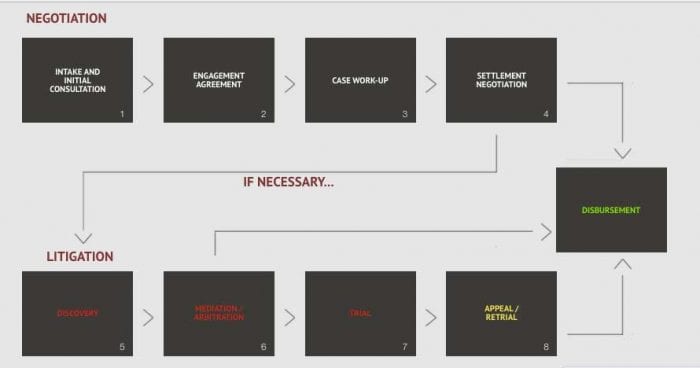What takes so long?
The process of getting a proper settlement is a complex one. Many of our clients are surprised to find how long it can take for a claim to be settled with an insurance company or presented to a judge or a jury. Prior to a complaint being filed with any court, an attorney investigates the circumstances surrounding an injury. The investigation typically focuses on the facts of the accident, the defendant or defendants, the injury itself, and ongoing medical treatment. An investigation can take a little as a few days or may last years. No two cases are alike and therefore each case must be investigated thoroughly prior to filing a lawsuit.
Negotiation.
Prior to filing the lawsuit the attorney will seek to resolve the matter through negotiation. This generally takes the form of a demand package. The demand package outlines the client’s background, the injury, the damages suffered, and the lasting impact. The demand package is sent to the insurance company for settlement purposes. Many times, a settlement can be obtained with the insurance company without ever needing to file a lawsuit.
Lawsuit.
However, if a settlement cannot be achieved through negotiation, it may be necessary to file a complaint with the court. The complaint is a legal document that begins the lawsuit, outlining the cause(s) of action for the court. Once the lawsuit is filed, it is the plaintiff’s responsibility to serve the defendant with the lawsuit. In Virginia, a plaintiff is given one year to serve the defendant from the date of filing the lawsuit. Sometimes a defendant can be served the complaint within a few days of filing the complaint, or it may take several months to have the defendant served with a lawsuit.
Response.
After the defendant is served with the lawsuit they must respond within 21 days; this response is called an answer. In personal injury actions, a copy of the lawsuit will generally be provided to the defendant’s insurance company.
Trial.
After the complaint has been answered and any counterclaims and/or cross-claims have been filed, the matter can be set for trial. The courts have limited availability for trials in Virginia as trial dockets have an unusually high caseload. For instance, in Loudoun County there are only three full time Circuit Court judges. This large caseload will often times prevent litigants from setting their trial in the near term.
Discovery.
Once the lawsuit has been answered the discovery process begins. Generally, the discovery process is the most time-consuming part of litigation. The rules of civil procedure allow the parties to a lawsuit to learn about each other’s claims and defenses. The rules of civil procedure provide four primary ways to learn about each other’s case. These methods include:
• Depositions
• Interrogatories
• Requests for production of documents
• Requests for admissions
A complex case can involve a months or years-long discovery process. During the discovery phase, motions, a request for the court to make a specific ruling or order, can be made by the parties. A motion takes many forms, including motions to compel, motions to exclude, motions in limine, motions to suppress, and motions to quash.
Trial & Appeals.
The case can still settle during the discovery phase of litigation. If, however, the case has not settled by the trial date a jury trial lasting one day or several weeks is likely. After a jury verdict is returned there can be several post-verdict motions filed with the court. These motions can request that the court set aside a jury verdict, or add or subtract to a jury damages award. Finally, should either party feel that the outcome was erroneous an appeal can be filed. An appeal to the Court of Appeals or Supreme Court can lengthen the timeframe by years.
We keep our clients informed throughout this process as we work to get them the most advantageous resolution possible for their case. For more detail on the case process, see our interactive web feature.
